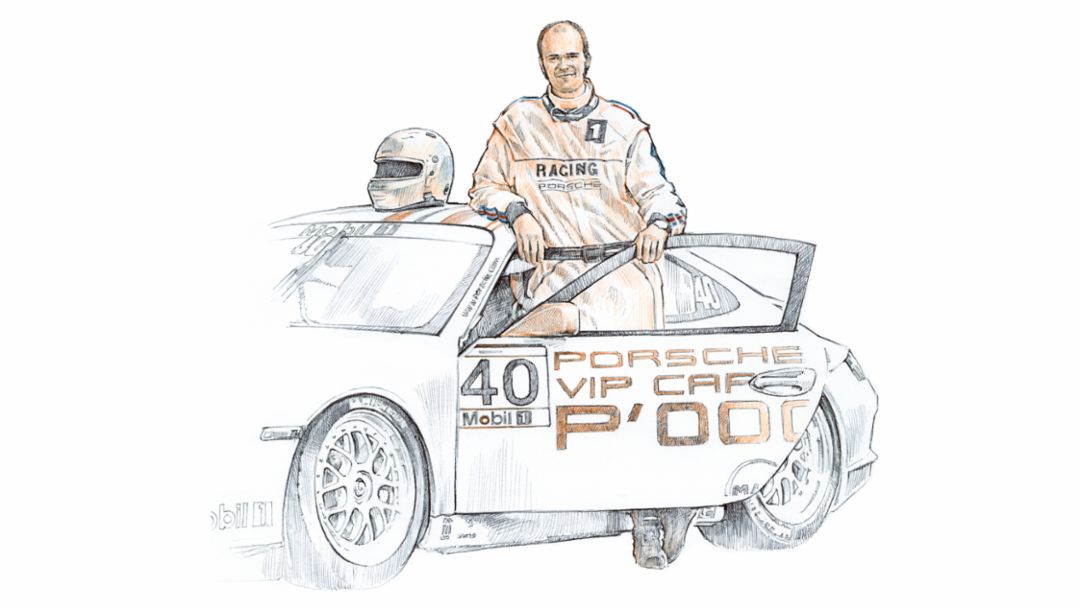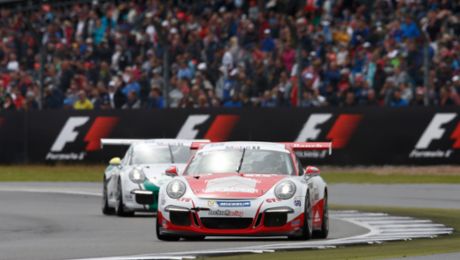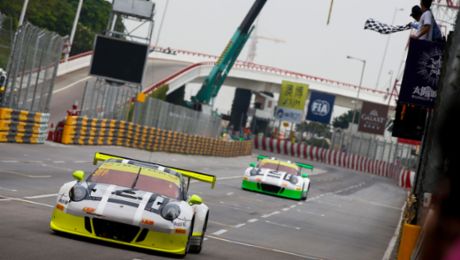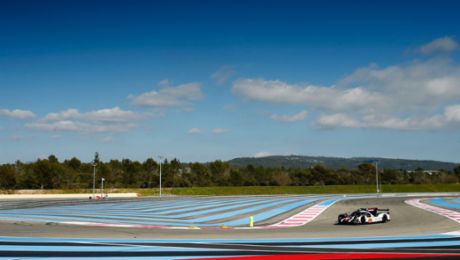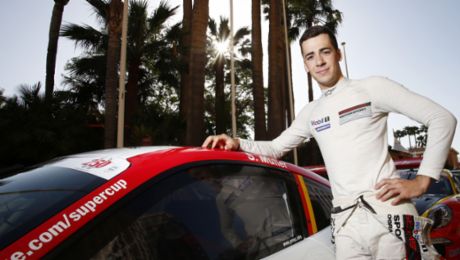Mika Häkkinen came, saw, and won. The rising star in the Formula One firmament achieved something in his Supercup guest start that none of his other two hundred successors has managed to accomplish—a bona fide victory. It was the first year of the Porsche Supercup in the exclusive environs of Formula One. The crew around then sport director Jost Capito scarcely knew what a successful enterprise they had just launched.
“This is a car for men, not boys”
Bona fide? In Monaco, Häkkinen needed a bit of assistance from Walter Röhrl. The rally world champion had just become a Porsche test-driver and was slated to do a guest drive himself. Four victories in the Monte Carlo Rally promised glamour in the tiny principality. “Häkkinen’s drive was a last-minute decision,” remembers Röhrl. “In training I drove in front of him to show him the right line to drive in the 911. The poor guy had never even been in that race car before.” The Supercup car was based on the Porsche 964. “265 hp, no power steering, no ABS, it was practically a series car,” says Rörhl. “And it was really tough to drive. I always said: ‘This is a car for men, not boys’.”
Häkkinen’s transformation from boy into man happened lap by lap. In the early going, Röhrl played the rearguard for the later Formula 1 champion, fending off the swashbuckling two-time champ of the German one-make cup, Uwe Alzen. One might think that the tight course through the principality would exacerbate the situation for the Finn. Instead, “Monaco was Mika’s lucky day,” says Röhrl. “There, even the 911 pros have a healthy respect. In Hockenheim, where there are run-off areas, they would have blown past him.” Ultimately Häkkinen drove home a well-deserved win, and underscored his exceptional talent a few weeks later in Budapest with another Supercup victory—without Röhrl on hand as his “bodyguard.”
“So many illustrious people”
If the idea of including VIP drivers no longer can be traced back to its originator, the motive remains clear. “We wanted to solidify the new Supercup and increase its visibility,” says Uwe Brettel, who headed up the series for six years, starting in 1996. “So we had people from a wide range of industries drive—caricaturists, pop singers, motorcycle world champions. There were so many illustrious people in the bunch, including 32 Formula One drivers.”
“The motorcycle riders,” recalls Brettel, “were a very special breed. Thanks to the safety cage, they always felt completely at ease and were always joking around.” All of the seven motorcycle world champions emerged from the 911 unscathed. One of them, the Texan Kevin Schwantz, once triggered a collective shudder among the Porsche hospitality crowd when he lifted his T-shirt. “He really had a lot of scars from his crashes,” Brettel remembers.
His debut in 1996 was in fact just the beginning
Luc Alphand also came from another world. For the Frenchman, his guest start was much more than just an “incredibly fun” race. It was an experience that would have an impact on his future. Alphand was a ski racer by vocation—a fearless speed-junkie. He twice won the legendary Streif downhill race in Kitzbühel, three times the small crystal globe for the downhill world cup, and once took an overall world cup title.
After a test day at Porsche in Weissach, he entered the 1996 Supercup race in Magny-Cours. Even today, nearly twenty years later, he still raves about the experience, when the “Porsche family” so warmly welcomed him: “It was my first real race. Everything was new to me. I was going around in awe like a little kid with his eyes popping out. It was a dream. I got to drive a Porsche on a racetrack in the context of Formula One.” Alphand took the opportunity another three times and managed a twelfth-place finish in Monaco.
But his debut in 1996 was in fact just the beginning. “Everything started there. With Porsche and the Supercup.” Everything? After the end of his skiing career, Alphand started a new career—as a race-car driver in various series. Ten years after his guest start, he took overall victory in the Dakar desert rally.
Racing’s in his blood
The competitiveness of the Supercup became ever more intense with the passing years, not least because it is not possible to gain any technological advantages. Having a level playing field is the highest principle. The teams can only tinker with minor factors. The cup cars? Pure-bred race cars. For guest starters, the hurdle became ever higher. That didn’t stop plenty more celebrities giving it a try, Prince Albert II von Thurn und Taxis of Germany being a prominent example. As the only son of Prince Johannes, who died young, and Princess Mariae Gloria, he is the patriarch of a noble lineage going back to the sixteenth century, which owns the largest private forest in Europe. He could go for equestrianism, golf, or tennis. “Do I look like a bore?” is his standard response to such questions. Racing’s in his blood, he says.
When the prince arrived at the Supercup final in September 2008, following Monza, he had just taken second place in the title race in a sports-car series. As always, the race was preceded by a day of testing; Porsche didn’t push the VIPs in at the deep end. “The car is impressive across the board; it has great agility, is very powerful, and has great balance,” he said after his time testing the car. He had a feeling: “To drive this car at its limits, you need a lot of experience. The race will be a challenge.”
That the heavens opened during qualifying was devastating for the 911 rookie; his 27th spot on the grid, sobering. On Sunday morning, the prince and his son attended a church service with a small Porsche delegation. “The cathedral in Monza is a wonderful church,” remembers von Thurn und Taxis. Was it help from above? Did the little St. Christophorus figurine that the prince always keeps in the cockpit play a role? Or was it just pure earthly talent on a dry course? He started moving up in the field from the get-go, and was extremely satisfied when he finished the race in 18th place: “The technical support, above all, demonstrated extraordinary competence, and the entire staff was friendly and interesting.”
A regular member of the Porsche racing family
The most recent VIP to try his luck in a racing 911 was a Hollywood superstar: Patrick Dempsey, who for ten years played a neurosurgeon in the hit TV series Grey’s Anatomy. In real life, the 50-year-old is driven by a passion for car racing. His endurance racing hobby led him to Porsche in 2013. A year later Dempsey risked his first sprint race—at the Supercup in Hockenheim, against 26 professionals. Of course, the pros blew right past the Hollywood beau, as Walter Röhrl might have described it. Dempsey came in 23rd, but happy: “Everyone was very kind to me. I had fun, and my start number 911 was cool.” He has meanwhile become a regular member of the Porsche racing family.
Another actor, the Austrian Tobias Moretti, provided an amusing anecdote. Röhrl had taken the Austrian under his wing, too. “He was totally relaxed,” Röhrl remembers. “Without any racing experience, he had nothing to lose, like some others who had a name.” Moretti was therefore easygoing about his last-place finish in training. Then came the start. The light goes off. Röhrl still remembers the moment as if it were yesterday. He grins. “In all the excitement, Moretti had put the car into the wrong gear. So 23 drivers took off driving forward—and the last man on the grid went backward.”
The Stars
Mika Häkkinen
In 1993 in Monaco, Häkkinen achieved something that so far none of his celebrity successors have managed: a Supercup victory. Indeed, the Formula One star actually repeated the feat shortly thereafter in Budapest.
Patrick Dempsey
For this actor, endurance racing is more than just a hobby. He has meanwhile become a regular member of the Porsche racing family.
Prince Albert II von Thurn und Taxis
The nobleman himself claims that racing is in his blood. In Monza in 2008 he advanced from the 27th spot on the grid to finish 18th.
Luc Alphand
For the former ski racer, his start at Magny-Cours in 1996 was only the beginning: Ten years later he took overall victory in the Dakar desert rally.
Walter Röhrl
The rally world champ put in a guest start in 1993 in Monaco. In training for the race, he showed the subsequent winner Mika Häkkinen the best line to take in the 911—evidently with success.
Info
Text first published in the Porsche customer magazine Christophorus, No. 372
By Eva-Maria Burkhardt, Illustrations by Bernd Schifferdecker

